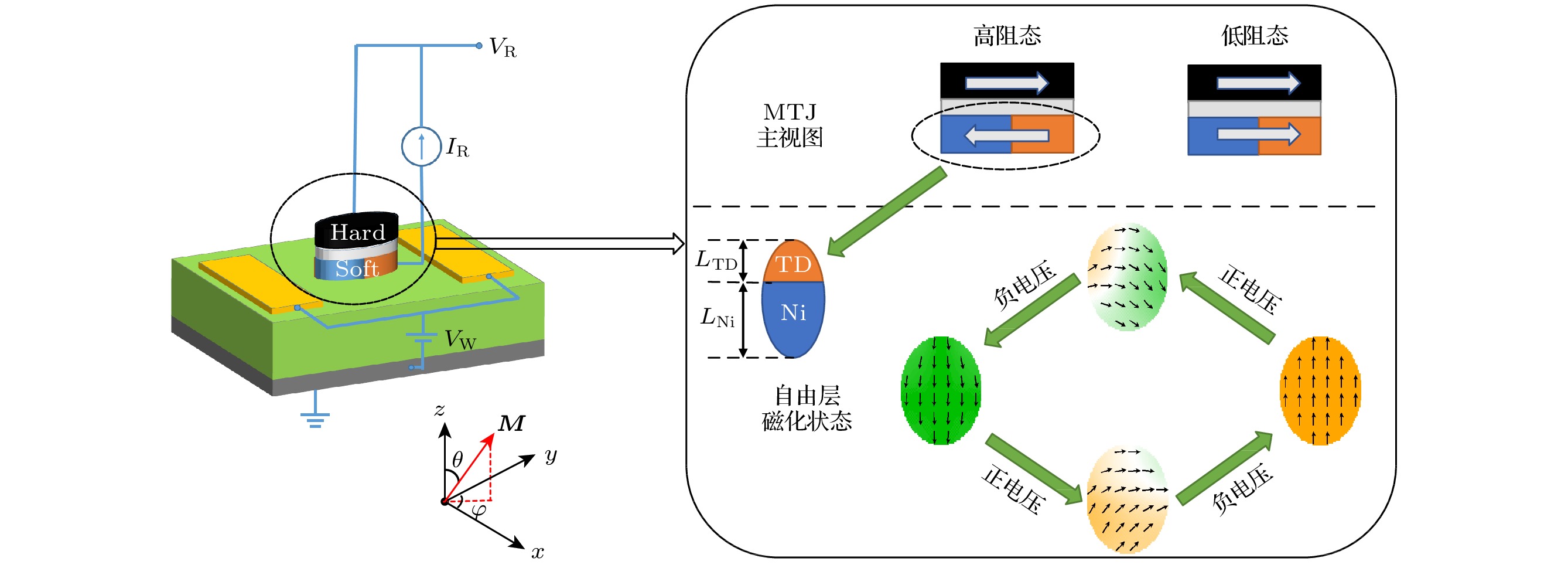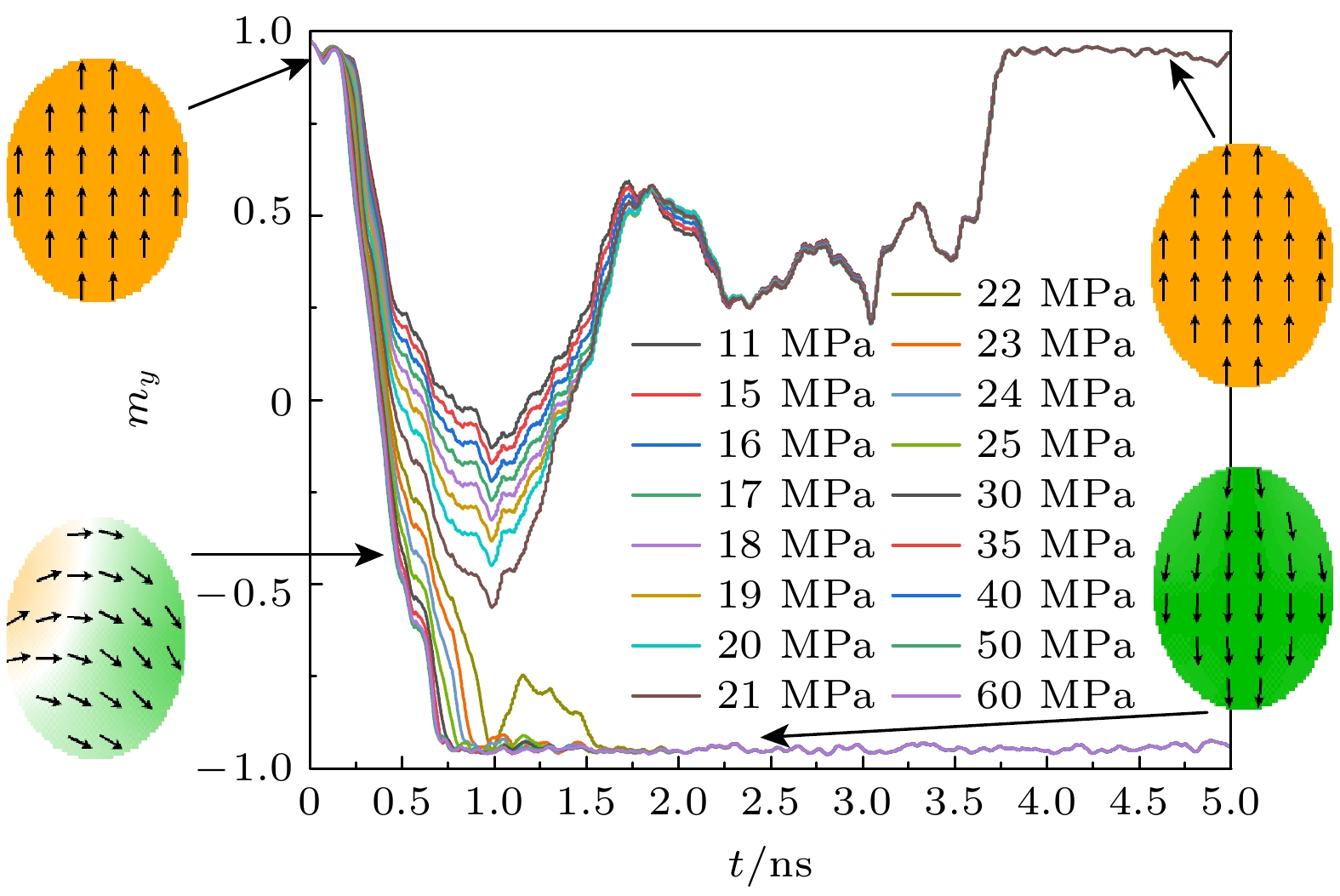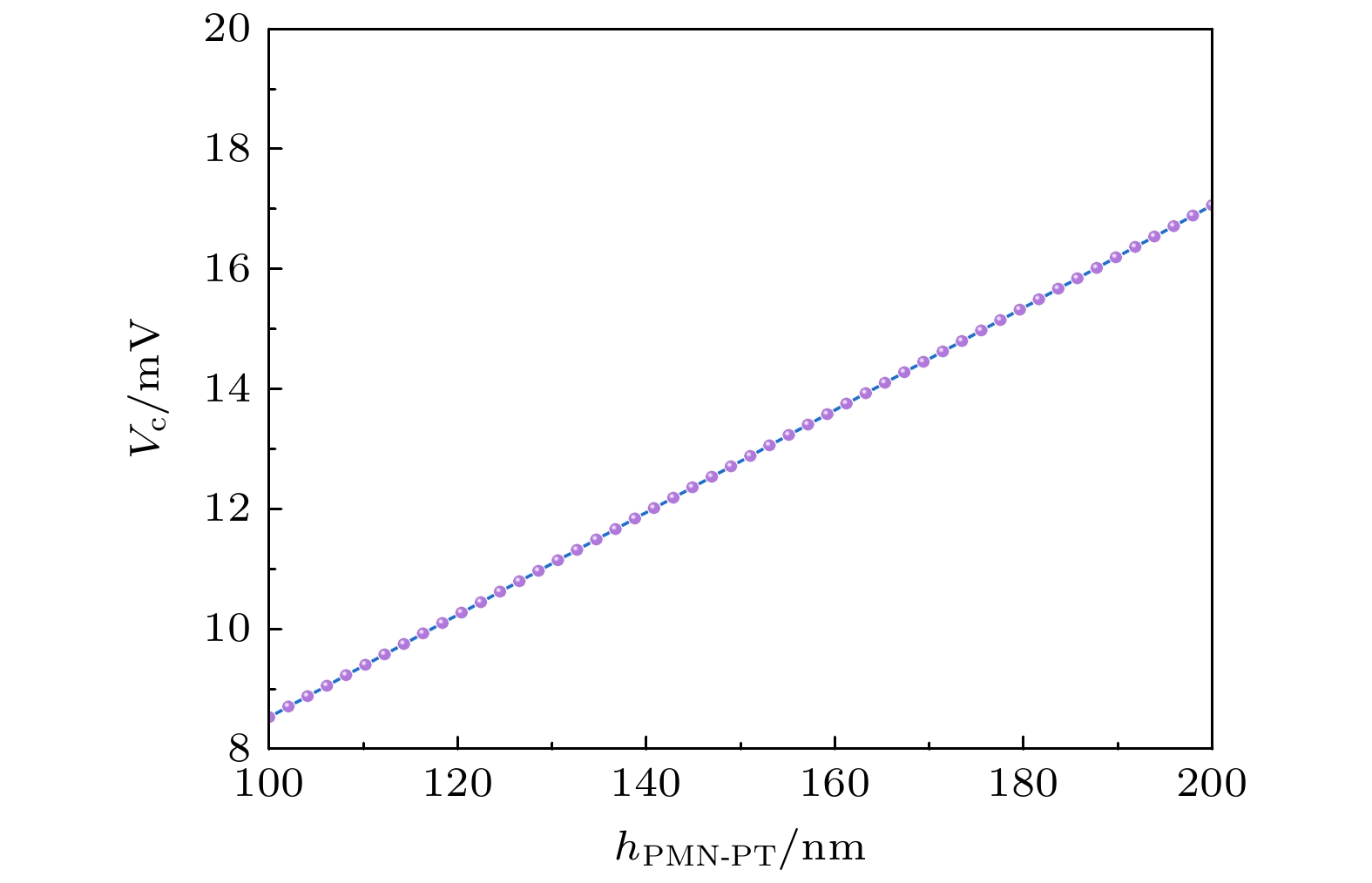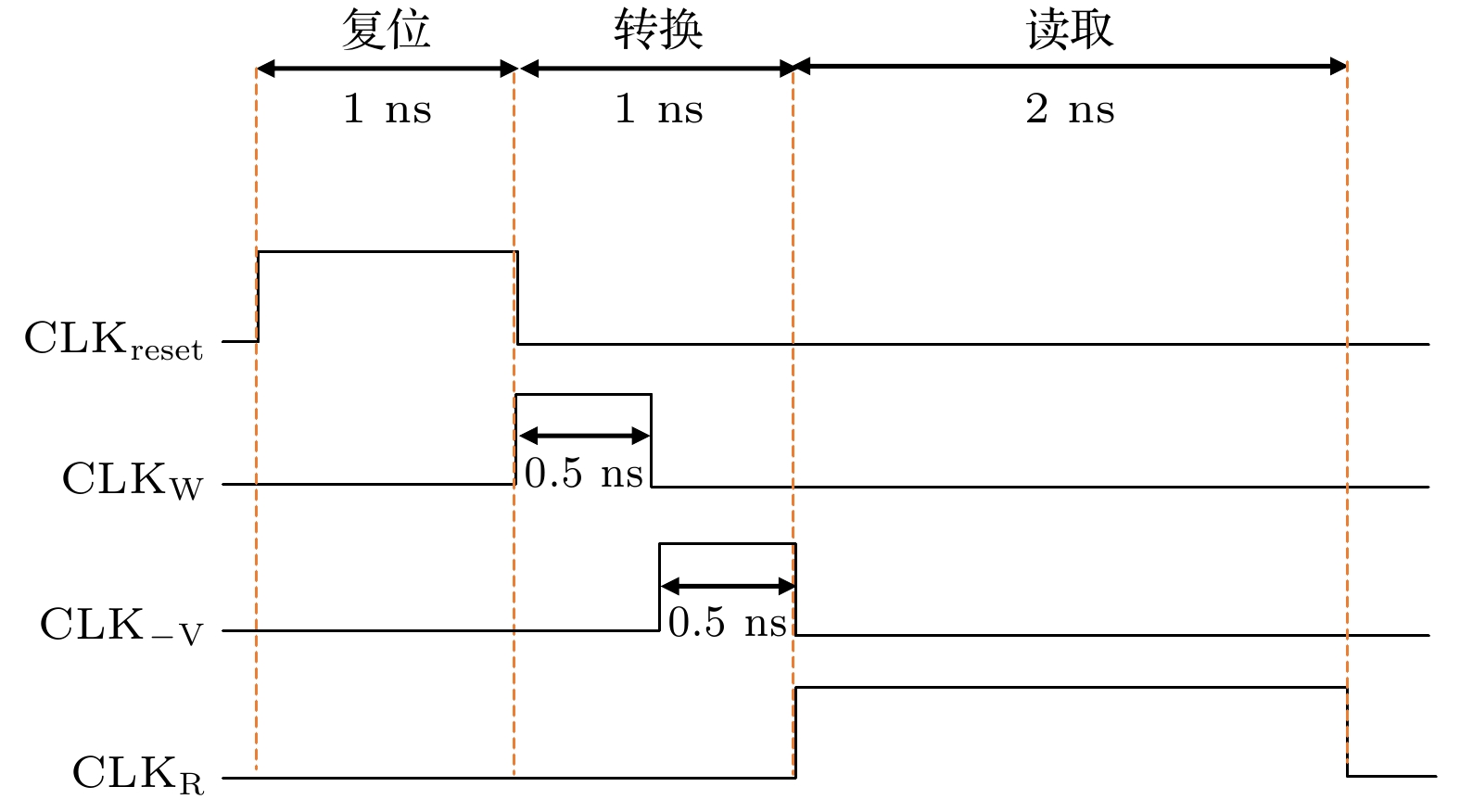-
本文提出了一种由8个磁性隧道结(magnetic tunnel junction, MTJ)构成的3位磁弹模数转换器(magneto-elastic analog-to-digital converter, MEADC), 该转换器中MTJ自由层为双组分多铁纳磁体. 通过对多铁纳磁体实施应变介导的电压调控, 可以实现零场条件下的确定性磁化翻转. 研究发现: 对于给定尺寸, 给定材料的双组分多铁纳磁体, 压电层厚度与双组分多铁纳磁体的临界翻转电压线性相关. 基于该原理, 通过调整压电层的厚度使得MEADC具有8个不同的电压切换阈值, 将模拟信号转换为8个多铁MTJ不同磁化状态组合. 同时, 设计了锁存比较器和独立的读取电路来检测MTJ的阻态, 以此实现了数字信号的输出. Monte Carlo功能模拟表明: 该MEADC在室温下写入成功率可达100%; 此外, 读写电路相互分离, 使得压电层厚度与MTJ的输出参考电压无关, 因此每个MTJ可设置相同的参考电压, 从而具有更高的读取可靠性. 微磁仿真和数值模拟分析发现: 该MEADC的工作频率可达250 MHz, 单次转换能耗仅为20 aJ; 与基于Racetrack技术的磁模数转换器相比, 能耗降低了1000倍, 采样速率提高了10倍. 本文提出的MEADC可为基于自旋电子器件的存算一体电路架构提供重要的技术支撑.
In recent years, the utilization of artificial intelligence and big data has led to the rise of compute-in-memory signal processing as the primary method for ADC design. Spintronic memory devices, which have non-volatile and low static power consumption characteristics, are particularly suitable for the design of low-power, high-bandwidth compute-in-memory ADCs. In this paper, a 3-bit magneto-elastic analog-to-digital converter (MEADC) is proposed, which comprises eight magnetic tunnel junctions (MTJs), where the MTJ free layer is a bicomponent multiferroic nanomagnet. The bicomponent multiferroic nanomagnet can attain deterministic magnetization switching under zero-field condition by regulating the strain-mediated voltage. It has been discovered that there is a linear correlation between the thickness of the piezoelectric layer and the critical flip voltage in a bicomponent multiferroic nanomagnet of a given size and material. Using this principle, the thickness of the piezoelectric layer is adjusted to allow the MEADC to have eight different voltage switching thresholds. This can make the analog signal converted into a combination of different magnetization states of eight multiferroic MTJ. A latch comparator and an independent read circuit are designed to detect the MTJ’s resistance state output a digital signal. Monte Carlo simulations indicate that the MEADC can achieve a 100% success rate of writing at room temperature. Additionally, the read circuit and write circuit are separated from each other, thus the same reference voltage can be set for each MTJ and result in higher readability. Micromagnetic simulation and numerical analysis demonstrate that the MEADC can operate at a maximum frequency of 250 MHz, and the energy consumption of a single conversion is only 20 aJ. Compared with the magnetic analog-to-digital converter based on the Racetrack technology, the energy consumption is reduced by 1000 times, and the sampling rate is increased by 10 times. The MEADC proposed in this paper offers an essential technical support for the spintronics-based compute-in-memory integrated circuit architecture. -
Keywords:
- magnetoelastic analog-to-digital converters /
- magnetic tunnel junctions /
- spintronics /
- nanomagnets
[1] Murmann B 2015 IEEE Solid-State Circuits Mag. 7 58
 Google Scholar
Google Scholar
[2] Zhang S, Huang K, Shen H 2020 IEEE T. Circuits I 67 1867
 Google Scholar
Google Scholar
[3] Jiang Y F, Lü Y, Jamali M, Wang J P 2015 IEEE Electron Device Lett. 36 511
 Google Scholar
Google Scholar
[4] Salehi S, DeMara R F 2018 Microelectron. J. 81 137
 Google Scholar
Google Scholar
[5] Wu B, Wang Z H, Li Y X, Wang Y, Liu D J, Zhao W S, Hu X B S 2021 IEEE T. Circuits II 68 617
 Google Scholar
Google Scholar
[6] Xia Y S, Yang X K, Dou S Q, Cui H Q, Wei B, Liang B J, Yan X 2024 AIP Adv. 14 045239
 Google Scholar
Google Scholar
[7] Wang Z 1991 IEEE T. Circuits Syst. 38 660
 Google Scholar
Google Scholar
[8] Liu J H, Yang X K, Cui H Q, Wei B, Li C, Chen Y, Zhang M, Li C, Dong D N 2019 J. Magn. Magn. Mater. 491 165607
 Google Scholar
Google Scholar
[9] Biswas A K, Ahmad H, Atulasimha J, Bandyopadhyay S 2017 Nano Lett. 17 3478
 Google Scholar
Google Scholar
[10] Bandyopadhyay S, Atulasimha J, Barman A 2021 Appl. Phys. Rev. 8 041323
 Google Scholar
Google Scholar
[11] Fidler J, Schrefl T 2000 J. Phys. D: Appl. Phys. 33 R135
 Google Scholar
Google Scholar
[12] Salehi-Fashami M, D’Souza N 2017 J. Magn. Magn. Mater. 438 76
 Google Scholar
Google Scholar
[13] Chen Y B, Wei B, Yang X K, Liu J H, Li J, Cui H Q, Li C, Song M X 2020 J. Magn. Magn. Mater. 514 167216
 Google Scholar
Google Scholar
[14] Ghanatian H, Farkhani H, Rezaeiyan Y, Bohnert T, Ferreira R, Moradi F 2022 IEEE Trans. Electron Devices 69 1691
 Google Scholar
Google Scholar
[15] Brown W F 1963 Phys. Rev 130 1677
 Google Scholar
Google Scholar
[16] Zeng J W, Yi P Y, Chen B Y, Huang C L, Qi X L, Qiu S, Fang L 2021 Microelectron. J. 116 105235
 Google Scholar
Google Scholar
[17] Fashami M S, Atulasimha J, Bandyopadhyay S J N 2012 Nanotechnology 23 105201
 Google Scholar
Google Scholar
[18] Peng R C, Hu J M, Momeni K, Wang J J, Chen L Q, Nan C W 2016 Sci. Rep. 6 27561
 Google Scholar
Google Scholar
[19] Dou S Q, Yang X K, Yuan J H, Xia Y S, Bai X, Cui H Q, Wei B 2023 IEEE Magn. Lett. 14 4500305
 Google Scholar
Google Scholar
[20] 豆树清, 杨晓阔, 夏永顺, 袁佳卉, 崔焕卿, 危波, 白馨, 冯朝文 2023 物理学报 72 157501
 Google Scholar
Google Scholar
Dou S Q, Yang X K, Xia Y S, Yuan J H, Cui H Q, Wei B, Bai X, Feng C W 2023 Acta Physica Sinica 72 157501
 Google Scholar
Google Scholar
[21] He Z, Fan D 2016 Proceedings of the 2016 International Symposium on Low Power Electronics and Design San Francisco, August 8–10, 2016 p314
[22] Park C J, Geddada H M, Karsilayan A I, Silva-Martinez J, Onabajo M 2013 Proceedings of the IEEE International Symposium on Circuits and Systems (ISCAS) Beijing, May 19–23, 2013 p141
[23] Dong Q, Yang K Y, Fick L, Fick D, Blaauw D, Sylvester D 2017 IEEE Trans. Very Large Scale Integr. VLSI Syst. 25 907
 Google Scholar
Google Scholar
[24] Qi X L, Yi P Y, Liu J H, Li C, Chen Y B, Qiu S, Xu N, Fang L 2021 IEEE Magn. Lett. 12 4503305
 Google Scholar
Google Scholar
-
参数 Tb0.7Dy0.3Fe2 Ni 杨氏模量 Y/(1010 Pa) 8 21.4 磁致伸缩系数 λs/10–4 6.0 -0.2 吉尔伯特阻尼系数 α 0.100 0.045 回磁比 γ /(105 rad·s–1·T–1) 2.21 2.21 饱和磁化率 Ms/(105 A·m–1) 8.00 4.85 交换作用常数 A/(10–11 J·m–1) 0.90 1.05 表 2 MEADC输入输出
Table 2. MEADC input/output.
Vwrite/mV Sout7-0 Binary 0—8.53 00000000 000 8.53—9.38 00000001 001 9.38—10.24 00000011 010 10.24—11.09 00000111 011 11.09—11.95 00001111 100 11.95—12.80 00011111 101 12.80—13.66 00111111 110 13.66—14.51 01111111 111 14.51— 11111111 — -
[1] Murmann B 2015 IEEE Solid-State Circuits Mag. 7 58
 Google Scholar
Google Scholar
[2] Zhang S, Huang K, Shen H 2020 IEEE T. Circuits I 67 1867
 Google Scholar
Google Scholar
[3] Jiang Y F, Lü Y, Jamali M, Wang J P 2015 IEEE Electron Device Lett. 36 511
 Google Scholar
Google Scholar
[4] Salehi S, DeMara R F 2018 Microelectron. J. 81 137
 Google Scholar
Google Scholar
[5] Wu B, Wang Z H, Li Y X, Wang Y, Liu D J, Zhao W S, Hu X B S 2021 IEEE T. Circuits II 68 617
 Google Scholar
Google Scholar
[6] Xia Y S, Yang X K, Dou S Q, Cui H Q, Wei B, Liang B J, Yan X 2024 AIP Adv. 14 045239
 Google Scholar
Google Scholar
[7] Wang Z 1991 IEEE T. Circuits Syst. 38 660
 Google Scholar
Google Scholar
[8] Liu J H, Yang X K, Cui H Q, Wei B, Li C, Chen Y, Zhang M, Li C, Dong D N 2019 J. Magn. Magn. Mater. 491 165607
 Google Scholar
Google Scholar
[9] Biswas A K, Ahmad H, Atulasimha J, Bandyopadhyay S 2017 Nano Lett. 17 3478
 Google Scholar
Google Scholar
[10] Bandyopadhyay S, Atulasimha J, Barman A 2021 Appl. Phys. Rev. 8 041323
 Google Scholar
Google Scholar
[11] Fidler J, Schrefl T 2000 J. Phys. D: Appl. Phys. 33 R135
 Google Scholar
Google Scholar
[12] Salehi-Fashami M, D’Souza N 2017 J. Magn. Magn. Mater. 438 76
 Google Scholar
Google Scholar
[13] Chen Y B, Wei B, Yang X K, Liu J H, Li J, Cui H Q, Li C, Song M X 2020 J. Magn. Magn. Mater. 514 167216
 Google Scholar
Google Scholar
[14] Ghanatian H, Farkhani H, Rezaeiyan Y, Bohnert T, Ferreira R, Moradi F 2022 IEEE Trans. Electron Devices 69 1691
 Google Scholar
Google Scholar
[15] Brown W F 1963 Phys. Rev 130 1677
 Google Scholar
Google Scholar
[16] Zeng J W, Yi P Y, Chen B Y, Huang C L, Qi X L, Qiu S, Fang L 2021 Microelectron. J. 116 105235
 Google Scholar
Google Scholar
[17] Fashami M S, Atulasimha J, Bandyopadhyay S J N 2012 Nanotechnology 23 105201
 Google Scholar
Google Scholar
[18] Peng R C, Hu J M, Momeni K, Wang J J, Chen L Q, Nan C W 2016 Sci. Rep. 6 27561
 Google Scholar
Google Scholar
[19] Dou S Q, Yang X K, Yuan J H, Xia Y S, Bai X, Cui H Q, Wei B 2023 IEEE Magn. Lett. 14 4500305
 Google Scholar
Google Scholar
[20] 豆树清, 杨晓阔, 夏永顺, 袁佳卉, 崔焕卿, 危波, 白馨, 冯朝文 2023 物理学报 72 157501
 Google Scholar
Google Scholar
Dou S Q, Yang X K, Xia Y S, Yuan J H, Cui H Q, Wei B, Bai X, Feng C W 2023 Acta Physica Sinica 72 157501
 Google Scholar
Google Scholar
[21] He Z, Fan D 2016 Proceedings of the 2016 International Symposium on Low Power Electronics and Design San Francisco, August 8–10, 2016 p314
[22] Park C J, Geddada H M, Karsilayan A I, Silva-Martinez J, Onabajo M 2013 Proceedings of the IEEE International Symposium on Circuits and Systems (ISCAS) Beijing, May 19–23, 2013 p141
[23] Dong Q, Yang K Y, Fick L, Fick D, Blaauw D, Sylvester D 2017 IEEE Trans. Very Large Scale Integr. VLSI Syst. 25 907
 Google Scholar
Google Scholar
[24] Qi X L, Yi P Y, Liu J H, Li C, Chen Y B, Qiu S, Xu N, Fang L 2021 IEEE Magn. Lett. 12 4503305
 Google Scholar
Google Scholar
计量
- 文章访问数: 4713
- PDF下载量: 81
- 被引次数: 0














 下载:
下载:






